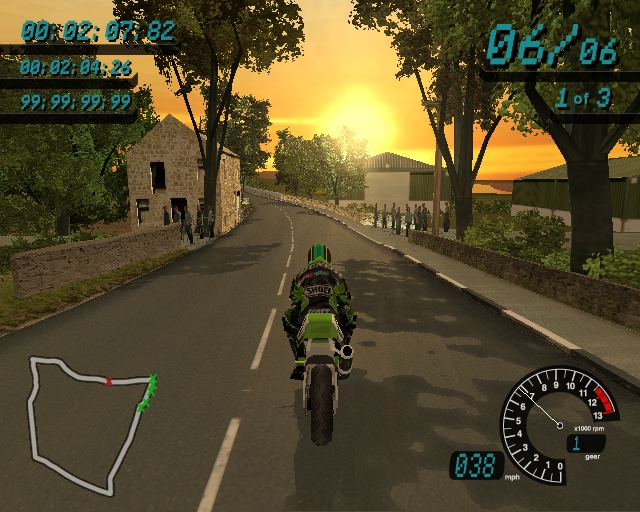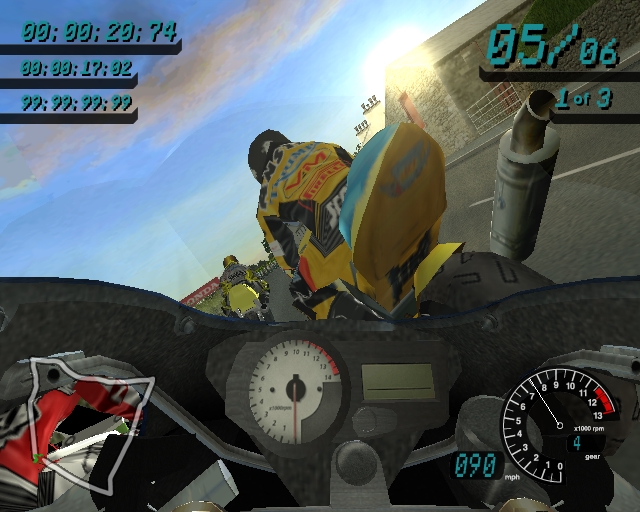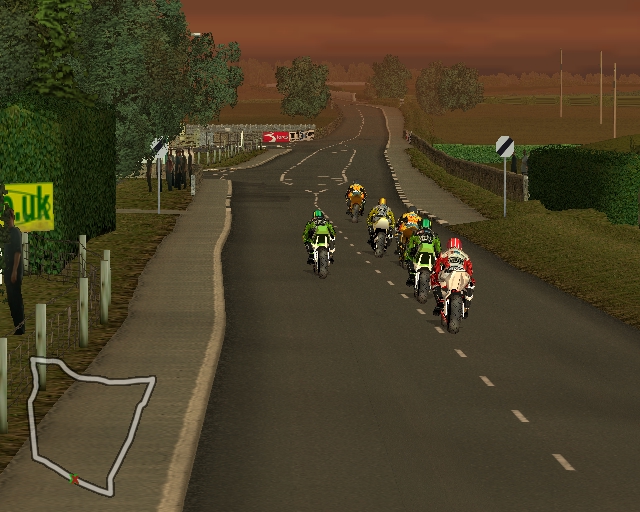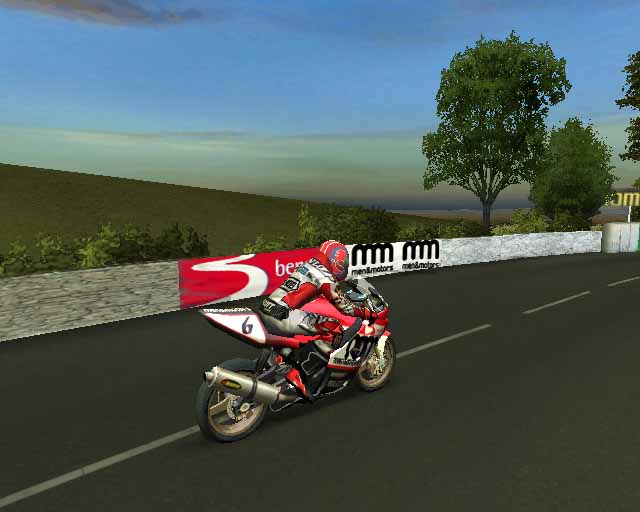There's a certain cachet to a racing game whose developer takes great pains to faithfully recreate real-world settings and ensure a comparatively authentic ride. Such is the case with Valcon Games' Suzuki TT Superbikes, an exercise based solely on the infamous Isle of Man Tourist Trophy (TT) motorcycle races. Yet despite Valcon's attention to authenticity, both in the racecourse itself and the myriad real-life bikes that navigate its high-speed nooks and crannies, the game will probably appeal only to those who truly appreciate this particular event and circuit, or those who take their racing seriously enough to be extremely patient during the rather steep learning curve. To all others, the course will seem too tight and confining, the bikes too twitchy, the controls too unforgiving, and the setting too monotonous. Despite its many positive attributes, Suzuki TT Superbikes may ultimately frustrate and bore as many riders as it will excite.
Infamous because of the many lives it has prematurely ended throughout its long history, the Isle of Man TT course is tremendously long (38 miles!) and tremendously skinny, and is sidelined with all manner of potentially deadly obstacles such as lampposts, fences, rock walls, pillars, and more. These hazards are not surprising, given the track is built into the island's quaint system of narrow roads, byways, and avenues, but the big question is whether such a venue translates well to the gaming world.
The answer is that it has a difficult time doing so, considering that in the game's PS2 format, players are compelled to use the standard PS2 controller. Simply, the bikes herein are bestowed with admirable, semiauthentic physics, but they're seemingly too fidgety--and the ribbon of track too narrow--for this controller. Had Suzuki TT Superbikes supported USB controllers such as tabletop joysticks or wheel and pedal units (it doesn't), or had it been a PC game in which players can utilize a supersophisticated tabletop analog control (it isn't), the story may have been different. But as it currently sits, you'll need to either opt for the relatively safe but sluglike "Novice" handling settings, or painstakingly and meticulously memorize every single nuance and detail of every section of the course to avoid continually crashing out. Things will improve as you become more practiced in the art of Superbiking, and in time you'll stop crashing so much and actually complete an event or two without finishing in last place. But when your main enemy remains the track and your bike's interaction with it, something's not right.
Of concern to those who enjoy challenging themselves over a variety of environments is the game's fixation with the Isle of Man. Granted, it's no average circuit. However, a long course doesn't necessarily lead to an interesting game. The designers at Valcon have broken the 38-mile course into various segments and then used those segments for all the game's stages and events. Thus, you aren't forced to tackle the entire thing over and over again each time you race.
Yet a segmented Isle of Man is still the Isle of Man. If you like huge elevation changes or wide and accommodating roadways, you've come to the wrong place. If you'd prefer wide shoulders or a desert or dirt environment, you've also come to the wrong place. And if you simply want a chance to drive more than one course, you've definitely come to the wrong place. But if you're an Isle of Man addict, welcome home. According to Valcon, the game features "every vital bump, wall, tree, and house" en route.

And it shows. The Suzuki TT Superbike environment is incredibly detailed, sporting such nifty visual perks as accurate lane markings, bus stops, an impressively wide range of foliage, flashbulb-popping photographers, roadside picnic tables and outdoor restaurants, licensed signage, adjoining avenues, sidewalks and curbing (most of which will play havoc on your bike's balance), and an assortment of buildings that may be unique in the genre because the majority of them are unique and purportedly true to life. Licensed up the yin-yang, the game also offers bikes from all the big manufacturers--40 in all, divided into four classes.
However, most everything besides the motorcycles looks static. The game's visual effects are extremely limited, eschewing such common racing periphery as smoke, sun glare, climate variables such as rain, and the like. Crashes are initially quite violent in that the rider separates from his bike and both tumble in rag-doll-fashion through the air or along the ground, but you won't see plumes of smoke or fire, broken parts, oil puddles, or anything of the like. Indeed, you'll merely wait a few moments after each crash before being reseated on your magically upright and unharmed steed.
The upside to this lack of sophisticated visual effects is a fast frame rate. Suzuki TT Superbikes flows very smoothly from moment to moment and turn to turn and never bogs down. The sensation of speed is quite convincing, if only because each segment is so detailed that you're constantly zipping by something. Activating the optional motion-blur technology makes the world appear to travel by at an even faster clip.

Rider animations are solid. He'll move back and forth across his bike as you negotiate him through each turn, use his little legs to walk his bike backward out of trouble, and lift his body just a bit when braking. From the start, he'll struggle to contain his machine as it rises and attempts to wheelie its way down the road or flip over backward on him. Fortunately, you can instruct him to hunch forward into a tuck to gather extra speed or sit back in the saddle when you want to transfer weight to the rear of the bike.
The physics modeling, while not perfect, should satisfy those who've ridden a bike in the real world and know the difference between a 250cc and 1000cc machine. Indeed, a skilled rider who's taken the time to get past the game's flaws and learn the course inside and out will eventually come to terms with his bikes' impressively complex idiosyncrasies and use weight-transfer maneuvers to his advantage. Word to the wise: The braking distance of some of these big 1000cc land rockets is absolutely huge, so prepare accordingly.
You'll get an entirely different view of things if you select the game's first-person or pseudo-first-person perspective, where you'll watch the events unfold while bobbing about like a cork in a tsunami. This may be the best perspective for sheer thrills, but it's also the worst for getting around each segment without falling off. It's downright harrowing--or sickening, depending on how well you can handle the constant, abrupt movements--but it does let you see what a real-world rider might see, including functioning gauges, handlebars, and a translucent windscreen.
Arguably more difficult than watching your bike crash or bob and weave about from the first-person view is enduring the never-ending sequence of game loads and unloads. Not only does Suzuki TT Superbikes go into temporary hibernation every time it moves from a menu interface to a gameplay interface and vice versa, but it also won't allow a race restart without first heading back to the menu and committing a double dose of unloading/loading. The degree to which this bogs down the fun factor cannot be overstated, particularly if you commonly wreck early and simply want to start over, or if you just want to see a replay.
There are other annoyances. The game's garage, for example, offers arcade-type general adjustments to six different areas of your bike, yet refuses to remember them from race to race. Your preference of camera perspective isn't saved, either. Once on the track, you'll quickly see that the artificially intelligent competition is almost completely immune to crashes--never falling off independently or during battles with each other, and generally going for a tumble only after you've made a deliberate effort to bash them to the ground. And even then they won't fall unless smacked very, very hard.
To its credit, Valcon has included a top-down map that you can switch, on the fly, from "local" (a few hundred meters ahead of you) to "global," in which the entire segment is displayed. In a game in which turn preparation is so critical and the track segments often so indistinguishable from one another, this map is indispensable.
Suzuki TT Superbikes also sounds really impressive, especially if you have the luxury of a surround speaker system. You'll likely want to turn down the music and tweak its many volume settings to your liking, but you'll be glad when you do. The various engines are very convincing, varying palpably from deep-throated roar to highly stressed whine and correctly signaling your current state of acceleration. Tire squeal is variable and very telling, and the track announcer/advisor is crucial for alerting you early to upcoming turns and particularly narrow passages. A smart rider will eventually switch the music completely off and minimize the engine sound so they can better listen to their tires and the announcer.

Multiplayer racing, conducted via a two-person split-screen interface, is perhaps the most exciting way to play the game. Here, you aren't forced to trounce the robotic AI riders, though you'll certainly become bitterly embattled with human opponents, who tend to fall from their bikes as easily as you do. However, the game's inherently sinewy tracks and twitchy handling characteristics won't change just because you're competing in multiplayer mode, so some degree of experience is necessary on both players' parts to ensure competitive racing.
Suzuki TT Superbikes is not easily mastered. That's a good thing in some respects, because it's a comparatively realistic game that will continue to challenge you in the weeks and months ahead. However, it will also frustrate you, due in no small part to the claustrophobic nature of its tracks, the control limitations of its sole platform, and its penchant for long, drawn-out interface loading procedures. And it certainly doesn't deliver an abundance of divergent environments. If you can handle its quirks and restrictions and if you enjoy simulations rather than arcade-type racers, you should find it to your liking. If any of the above bothers you, you may want to steer elsewhere.
